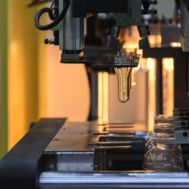
Industries

Applications

Cookie Consent
Cookies are used for statistical purposes and to improve the site.
Cookies will be used after you click "Accept" or if you continue using Dynisco.com
To find out more please review our Privacy Policy.
Capillary rheometers are one of the most common types of analytical devices, used to analyze the flow properties of viscoelastic polymer materials under processing conditions. The rheometer consists of a heated barrel (at a specific temperature) and a capillary die where the heated-softened plastic material is forced to flow by means of a piston. The piston is moving down the barrel at different speeds and apply force/pressure to the melted polymer. The speeds of the piston (and resulted shear rates) are defined by the operator in a decreasing manner and the force/pressure needed to maintain each of the speed is recorded by means of either a load cell or a pressure sensor. The LCR7001 can utilize both load cell and pressure transducer simultaneously in order to produce information on both the force applied to the polymer sample and the resulting pressure at the die entrance. These signals along with piston position is sent back to the rheometer`s software.
There is a common question among our users - What is the advantage or disadvantage of using a pressure sensor in compare with a load cell? The fact is- a pressure transducer needs more regular maintenance and cleaning than load cell. The pressure transducer tip is sensitive and can be damaged by using improper cleaning tool. Also, there might be some thermal losses from the pressure probe. However, a pressure transducer gives more accurate data for testing materials of low viscosity since the portion of the measured force/pressure is low for these materials and the frictional force from the piston tip can cause significant error. By reading the data from a pressure transducer, the errors from the plastic leakage across the piston can be also avoided. Furthermore, by inserting the pressure transducer right before the capillary die, the barrel pressure drop from piston tip to the pressure sensor can be avoided. Normally the barrel pressure drop can be assumed to be negligible in compare with capillary pressure drop due to the large difference between the barrel and die geometries. However; for short capillaries with large diameter this error can be significant. As a result, the rheometer provides more repeatable data by receiving the data from a pressure transducer. This is confirmed via the images below. These flow curves are obtained from various shear sweep tests on low density polyethylene (LDPE) samples using three different dies with different diameters. The viscosity data of the first image was obtained from the load cell reading and the viscosity data of the second image was obtained from the pressure sensor. The repeatability of the data using pressure sensor is better than load cell. This is more evident for high shear rates as the barrel has longer effective length and consequently higher pressure.

38 Forge Parkway,
Franklin MA 02038
+1 508 541 9400
Pfaffenstr. 21, 74078,
Heilbronn, Germany
+49 7131 297 0
Lot 3615, Jalan SM 6/8
32040 Seri Manjung, Perak, Malaysia
+605 6884014